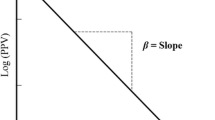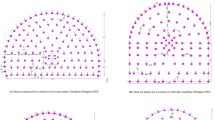Abstract
This study aims to investigate capability of the vibration prediction approaches, comprehensively. Field investigations were performed in a sandstone quarry. All the main conventional scaled distance equations were evaluated. A multivariate equation that contains blast design parameters was created by stepwise regression. A robust artificial neural network model was constructed. Effect of the additional parameters on success of the vibration estimation was examined. The success of the equations was evaluated considering the measurement distance. Evaluation of vibrations based on the measurement distance provided an opportunity to examine effectiveness of the equations that contains inelastic attenuation factor. Suitable error measures were investigated to examine the precision of vibration estimation. Both percentage errors and symmetric errors were found to be useful. Increase in the measurement distance was resulted in increase in prediction error. The classical scaled distance equations were found to be quite successful. The multivariate equation and artificial neural network model did not made better predictions than the scaled distance equations for long distance. The equations with inelastic attenuation formula do not have any advantage over classical scaled distance equations.








Similar content being viewed by others
References
Aler J, Du Mouza J, Arnould M (1996) Evaluation of blast fragmentation efficiency and its prediction by multivariate analysis procedures. Int J Rock Mech Mın 33:189–196. https://doi.org/10.1016/0148-9062(95)00055-0
Ambraseys NR, Hendron AJ (1968) Dynamic behaviour of rockmasses. In: Stagg KG, Zienkiewicz OC (eds) Rock mechanics in engineering practice. Wiley, London, pp 203–207
Armaghani DJ, Momeni E, Abad SVANK, Khandelwal M (2015) Feasibility of ANFIS model for prediction of ground vibrations resulting from quarry blasting. Environ Earth Sci 74:2845–2860. https://doi.org/10.1007/s12665-015-4305-y
Armstrong JS, Collopy F (1992) Error measures for generalizing about forecasting methods: empirical comparisons. Int J Forecast 8:69–80. https://doi.org/10.1016/0169-2070(92)90008-W
Ash RL (1963) The mechanics of rock breakage (part 2)—standards for blast design. Pit Quarry 56:118–122
Attewell PB, Farmer IW, Haslam D (1965) Prediction of ground vibration parameters from major quarry blasts. Min Miner Eng 5:621–626
Beale MH, Hagan MT, Demuth HB (2018) Neural network toolbox user’s guide. The MathWorks Inc, Natick
Birch WJ, Chaffer R (1983) Prediction of ground vibrations from blasting on opencast sites. Inst Min Metall Trans Sec A (Min Ind) 92:A102–A107
Davies B, Farmer IW, Attewell PB (1964) Ground vibration from shallow sub-surface blasts. The Eng 217:553–559
Davydenko A, Fildes R (2016) Forecast error measures: critical review and practical recommendations. In: Gilliland M, Tashman L, Sglavo U (eds) Business forecasting: practical problems and solutions. Wiley, New Jersey, pp 238–250
Dehghani H, Ataee-pour M (2011) Development of a model to predict peak particle velocity in a blasting operation. Int J Rock Mech Min 48:51–58. https://doi.org/10.1016/j.ijrmms.2010.08.005
Dindarloo SR (2015) Prediction of blast-induced ground vibrations via genetic programming. Int J Min Sci Technol 25:1011–1015. https://doi.org/10.1016/j.ijmst.2015.09.020
Dowding CH (1971) Response of buildings to ground vibration resulting from construction blasting. Ph.D. thesis, Department of Civil Engineering, University of Illinois at Urbana-Champaign, Illinois, p 204
Duvall WI, Petkof B (1959) Spherical propagation of explosion generated strain pulses in rock, RI 5483. US Bureau of Mines, Washington DC
Faradonbeh RS, Armaghani DJ, Monjezi M (2016) Development of a new model for predicting flyrock distance in quarry blasting: a genetic programming technique. B Eng Geol Environ 75:993–1006. https://doi.org/10.1007/s10064-016-0872-8
Garson GD (2014) Multiple regression. Statistical Associates Publishing, Asheboro
Ghasemi E, Ataei M, Hashemolhosseini H (2013) Development of a fuzzy model for predicting ground vibration caused by rock blasting in surface mining. J Vib Control 19:755–770. https://doi.org/10.1177/1077546312437002
Ghosh A, Daemen JK (1983) A simple new blast vibration predictor based on wave propagation laws. In: Proceedings of the 24th US symposium on rock mechanics, Texas USA, pp 151–162
Goodwin P, Lawton R (1999) On the asymmetry of the symmetric MAPE. Int J Forecast 15:405–408. https://doi.org/10.1016/S0169-2070(99)00007-2
Gujarati DN (2006) Essentials of econometrics, 3rd edn. McGraw-Hill-Irwin, Boston
Gupta RN, Roy PP, Bagachi A, Singh B (1987) Dynamic effects in various rock mass and their predictions. J Min Met Fuels 35:55–462
Gupta RN, Roy PP, Sing B (1988) On a blast induced blast vibration predictor for efficient blasting. In: Proceedings of the 22nd international conference of safety in mines, Beijing China, pp 1015–1021
Gustafsson R (1973) Swedish blasting technique. SPI, Gothenburg
Hajihassani M, Armaghani DJ, Monjezi M, Mohamad ET, Marto A (2016) Blast-induced air and ground vibration prediction: a particle swarm optimization-based artificial neural network approach. Envıron Earth Scı 74:2799–2817. https://doi.org/10.1007/s12665-015-4274-1
Hasanipanah M, Naderi R, Kashir J, Noorani SA, Qaleh AZA (2016) Prediction of blast-produced ground vibration using particle swarm optimization. Eng Comput 33:173–179. https://doi.org/10.1007/s00366-016-0462-1
Hudaverdi T, Akyildiz O (2017) Investigation of the site-specific character of blast vibration prediction. Environ Earth Sci 76:138. https://doi.org/10.1007/s12665-017-6456-5
Hudaverdi T, Kuzu C, Fisne A (2012) Investigation of the blast fragmentation using the mean fragment size and fragmentation index. Int J Rock Mech Min 56:136–145. https://doi.org/10.1016/j.ijrmms.2012.07.028
Hyndman RJ, Koehler AB (2006) Another look at measures of forecast accuracy. Int J Forecast 22:679–688. https://doi.org/10.1016/j.ijforecast.2006.03.001
Indian Standards (1973) Criteria for safety and design of structures subjected to underground blast, Bulletin no: IS-6922. Indian Standards, New Delhi
ISEE (2015) Field practice guidelines for blasting seismographs. International Society of Explosives Engineers, Cleveland
Jaeger JC, Cook NGW (1979) Fundamentals of rock mechanics, 3rd edn. Chapman and Hall, London
Khandelwal M (2012) Application of an expert system for the assessment of blast vibration. Geotech Geol Eng 30:205–217. https://doi.org/10.1007/s10706-011-9463-4
Khandelwal M, Singh TN (2007) Evaluation of blast-induced ground vibration predictors. Soil Dyn Earthq Eng 27:116–125. https://doi.org/10.1016/j.soildyn.2006.06.004
Khandelwal M, Singh TN (2009) Prediction of blast-induced ground vibration using artificial neural network. Int J Rock Mech Min 46:1214–1222. https://doi.org/10.1016/j.ijrmms.2009.03.004
Kosko B (1994) Neural networks and fuzzy systems: a dynamical systems approach to machine intelligence. Prentice Hall, New Delhi
Langefors U, Kihlstrom B (1963) The modern technique of rock blasting. Wiley, New York
Lippman RP (1987) Introduction to computing with neural nets. IEEE Assp Mag 4:4–22
McNeill FM, Thro E (1994) Fuzzy logic: a practical approach. AP Professional, Boston
Mehrotra K, Mohan CK, Ranka S (2000) Elements of artificial neural networks. MIT Press, Cambridge
Monjezi M, Hasanipanah M, Khandelwal M (2013) Evaluation and prediction of blast-induced ground vibration at Shur River Dam, Iran, by artificial neural network. Neural Comput Appl 22:1637–1643. https://doi.org/10.1007/s00521-012-0856-y
Nicholls HR, Johnson CF, Duvall WI (1971) Blasting vibrations and their effects on structures, Bulletin no. 656. US Bureau of Mines, Washington DC
Richart FE Jr, Hall JR Jr, Woods RD (1970) Vibrations of soils and foundations. Prentice-Hall, New Jersey
Roy PP (1991) Vibration control in an opencast mine based on improved blast vibration predictors. Min Sci Technol 12:157–165. https://doi.org/10.1016/0167-9031(91)91642-U
Saadat M, Khandelwal M, Monjezi M (2014) An ANN-based approach to predict blast-induced ground vibration of Gol-E-Gohar iron ore mine, Iran. J Rock Mech Geotech Eng 6:67–76. https://doi.org/10.1016/j.jrmge.2013.11.001
Shcherbakov MV, Brebels A, Shcherbakova NL, Tyukov AP, Janovsky TA, Kamaev VA (2013) A survey of forecast error measures. World Appl Sci J 24:171–176
Shoop SA, Daemen JJK (1983) Site-specific predictions of ground vibrations induced by blasting. In: Proceedings of TMS/AIME meeting, Atlanta USA, pp 83–95
Singh TN (2004) Artificial neural network approach for prediction and control of ground vibrations in mines. Min Technol (Trans Inst Min Metall A) 113:251–256. https://doi.org/10.1179/037178404225006137
Tabachnick BG, Fidell LS (2013) Using multivariate statistics. Pearson Education, New Jersey
Tripathy G, Gupta ID (2002) Prediction of ground vibrations due to construction blasts in different types of rock. Rock Mech Rock Eng 35:195–204. https://doi.org/10.1007/s00603-001-0022-9
Tugrul A, Undul O (2006) Engineering geological characteristics of Istanbul greywackes. In: Proceedings of the 10th international association for engineering geology and the environment (IAEG) congress, Nottingham United Kingdom, paper no. 395
Zadeh L, Kacprzyk J (eds) (1992) Fuzzy logic for the management of uncertainty. Wiley, New York
Zhou J, Li X, Shi X (2012) Long-term prediction model of rockburst in underground openings using heuristic algorithms and support vector machines. Safety Sci 50:629–644. https://doi.org/10.1016/j.ssci.2011.08.065
Zhou J, Li X, Mitri HS (2016) Classification of rockburst in underground projects: comparison of ten supervised learning methods. J Comput Civil Eng 30:1–19. https://doi.org/10.1061/(ASCE)CP.1943-5487.0000553
Acknowledgements
This study was supported by the Research Fund of the Istanbul Technical University (No: MGA-2017-40581), and partially supported by The Scientific and Technological Research Council of Turkey—TUBİTAK—(No: 217M071). The authors are grateful to the Istanbul Technical University and TUBITAK for their financial support.
Author information
Authors and Affiliations
Corresponding author
Additional information
Publisher's Note
Springer Nature remains neutral with regard to jurisdictional claims in published maps and institutional affiliations.
Rights and permissions
About this article
Cite this article
Hudaverdi, T., Akyildiz, O. Evaluation of capability of blast-induced ground vibration predictors considering measurement distance and different error measures. Environ Earth Sci 78, 421 (2019). https://doi.org/10.1007/s12665-019-8427-5
Received:
Accepted:
Published:
DOI: https://doi.org/10.1007/s12665-019-8427-5




